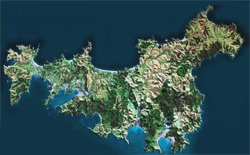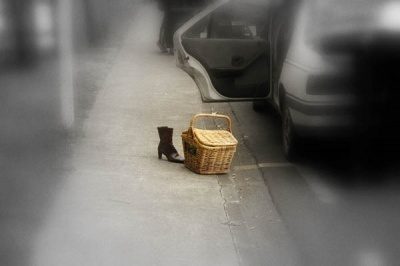Please show your support of Waihekepedia by adding a link to us from your web site. Waihekepedia T Shirts now available at the Ostend Market
Waiheke Island
Waiheke Island is situated in the Hauraki Gulf (Tiikapa Moana-o-Hauraki)
Latitude (DMS): 36° 47' 60 S Longitude (DMS): 175° 5' 60 E
The 175th meridian passes through the island in Church Bay and Matiatia, not far from Mud Brick Restaurant. The apogee of Waiheke Island is in Spain, not far from Gibraltar.
Only 17km from central Auckland, Waiheke is an easy 35-40 minute ferry ride from the city's downtown piers. It is the second largest island in the Hauraki Gulf, after Great Barrier Island. Its proximity to Auckland means it has become New Zealand third most populated island (first is North Island, second is South Island).
The climate is often said to be generally warmer than Auckland with less humidity and rain, and more sunshine hours. The evidence for this claim has not been supplied, although in the summer locals note with frustration the dark rainclouds over the Ithsmus whilst the island remains parched and smaller water tanks run dry.
Waiheke Island has an area of 9324 hectares and a permanent population of around 8000 residents. Visitors at the peak of summer are said to bring numbers on the island up to 25,000 to 30,000 but there is no real proof. According to former City Councillor, Faye Storer, an earlier community board made up that number when they were pressed to provide a number. The actual estimate could easily be calculated by the ferry counts (inbound minus outbound over a six week period).
For many years considered something of a refuge for anyone in need of refuge, Waiheke has these days become an eclectic community, made of all social strata. Luxury homes pepper the hills and coastline, while the valleys are still full of modest homes and baches.
Tangata whenua for the island is Ngati Paoa, one of the tribes in the Hauraki Confederation. The island's marae, however, is Piritahi Marae, a pan-cultural centre established on a city council reserve at the western end of Blackpool. Its long-term chairman and prominent kaumatua was Kato Kauwhata who died on 11 November 2007.
History
According to local historian Paul Monin, no evidence can be found as to what the name "Waiheke" means. Anecdotal stories circulated by tourism groups are urban legends. Monin explained that because of the Maori wars in the area, by the time Pakeha began recording local history, those Maori who would have known the original meaning were dead. The conventional explanation is that it means "Cascading Waters" with an attached story relating to a modest waterfall on the island. This explanation is doubtful in part because except in storms, most water on Waiheke drips - the island does not have cascading rivers. However, Wai also means a form of memory, explained by some Maori scholars as the memory of all that was and will be, and Heke means a migrant or party of migrants. Could this be the island of migrants remembering who they are? Seems to accurately describe many folk on the island.
Note: Some Maori from Ngati Whatua suggest Waiheke may have been a family name. This needs to be investigated.
In a scholarly and comprehensive book called Te Takoto o te Whenua o Hauraki - Hauraki Landmarks (Reed, 2000), however, Taimoana Tuuroa tells a very different story. He says the literal translation of Waiheke is indeed 'descending waters'. Maori history has it that during exploration of in the inner gulf, the waka Arawa made a call at the island and Kahumatamomoe, the son of Tamatekapua, came ashore. "On landing upon the flat rocky shore, he needed to relieve himself and did so proclaiming that his micturating waters had descended upon the land," writes Tuuroa (P193).
Tuuroa spent many years researching the Hauraki lands and their people, having grown up among tribal leaders. His life was filled research encounters, helped by his job as a surveyor. Reed's [page about the book]http://www.reed.co.nz/products.cfm?view=1171&catID=46 is currently down (Nov 07).

